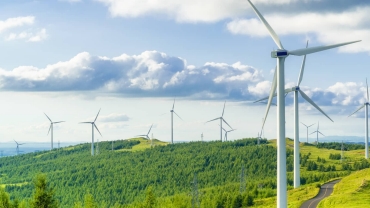
For more than a decade, the European Union (EU) has been moving towards a lower carbon, greener future for its economy, especially for energy-intensive industries through its Emissions Trading System (ETS), implemented to issue emissions allowances and limit greenhouse gas (GHG) emissions using carbon pricing measures. The EU ETS has become even more ambitious, with increasing carbon costs to be borne (or covered) by manufacturers and fewer emissions allowances.
The EU has also set itself ambitious CO2 emissions reduction targets through its “Fit for 55” roadmap towards a 55% reduction in emissions by 2030, a key measure of the EU Green Deal that aims to achieve carbon neutrality by 2050.
Amid the EU efforts towards a net-zero emissions future, and while high carbon prices should encourage companies to reduce their emissions, carbon leakage remains a risk. Imported products produced outside the EU are not included in a company’s emissions quota, even though they are sold in the EU, thereby creating unfair competitive conditions for manufacturers using the trading system.
In response to the question, how can the EU prevent carbon leakage and avoid unfair competition in its trading system, the European Commission (EC) has proposed an EU Carbon Border Adjustment Mechanism (CBAM). In this study, our PwC and Strategy& experts provide a detailed analysis of the EU trading system, CBAM implementation methods, opportunities and challenges, and key success factors.
CBAM: Is it time to accelerate decarbonisation strategies?
Implementing a Carbon Border Adjustment Mechanism in the EU
In March 2022, the EU Council adopted the EC proposal to implement a CBAM that would apply to direct emissions from imported upstream products. In June 2022, the EU Council adopted general approaches as part of its “Fit for 55” package, including a progressive phasing-out of free allowances for sectors included in the CBAM from 2026 to 2035, with a slower reduction in free allowances at the beginning of the ten-year period. In its decision, the Council also asked the Commission to assess the need for measures dedicated to exports, to offset the negative impact of the CBAM on European players’ competitiveness.
Sectors impacted by the CBAM
The CBAM will initially cover five industrial sectors: fertilisers, electricity, cement, aluminium, and iron and steel, representing more than 10% of gross value added (electricity and manufacturing), and more than 45% of total CO2 emissions.

An effective CBAM and its operational challenges
Complex value chains and products should be considered when establishing a CBAM for Europe. If the CBAM does not cover products downstream of the value chain, and assuming that carbon costs are passed through to customers, it is likely that imported downstream products would be more competitive than downstream products manufactured in Europe. If this were to occur, it would have a significant social impact on Europe, with the risk of manufacturers deciding to relocate their production to non-EU countries.
The CBAM as described in the latest EC proposal, adopted by the Council, could be further improved if the following were taken into consideration:
Total CO2 emissions, rather than just direct emissions that represent only a fraction of the carbon price paid by EU players;
All products along a value chain, as partial application might incentivise the import of intermediate products rather than input products;
Exports, as EU manufacturers could become less competitive if free allowances are phased out (an increase in costs of up to 50% when exporting energy-intensive products such as cement).
Prices of products sold in EU countries are expected to increase due to three factors: decreasing free allowances on European production, the introduction of the CBAM on imported products, and an increasing carbon price. In the context of high inflation, improving carbon efficiency will be crucial to avoid price increases and for EU manufacturers to remain competitive.

Our thoughts: what are the regulatory obligations and how will they affect your business?
The CBAM measures will result in increased reporting obligations for importers, marking an important shift towards greater decarbonisation.
From October 2023, during the transitional period, a quarterly CBAM report will need to be submitted, detailing the quantities of goods imported and their emissions. In the long term, in addition to the financial implications of the obligation to purchase allowances, an annual report will be required and only authorised registrants will be able to import goods subject to CBAM.
These changes raise a number of issues that require careful consideration. To better understand these challenges, watch this short video to find out how you can meet the new obligations and what you can do to ensure your company remains highly competitive in an ever-changing environment.
CBAM: How to prepare for the new regulatory obligations?
Incentivising decarbonisation
A robust CBAM should not simply shift EU emissions elsewhere, but enable decarbonisation on a global scale. The CBAM should also have the additional advantage of making EU domestic decarbonisation policies more politically palatable since it would insulate EU industry from cheaper foreign imports.
Decarbonisation is therefore becoming critical not only to maintain competitiveness versus direct competitors and alternative products, but also for manufacturers in order to maintain or improve margins. Customers’ willingness to pay a premium for green products will depend on multiple factors including the cost of using brown products as opposed to green ones, given existing regulations and reputational risks.
Across all the sectors concerned, the introduction of purchasing criteria favouring green products in public tenders will be key to ensuring market potential and reasonable ROI for European manufacturers investing in decarbonisation technologies such as carbon capture and storage (CCS) and facilitating the transition towards greener consumption.
Conclusion
The CBAM is one of the key measures of the EU Green Deal. As demonstrated by the results of the EU Green Deal survey conducted by PwC Tax Teams, many companies have a relatively low level of awareness of what the EU Green Deal is and its potential implications on their businesses. In fact, our EU Green Deal survey also shows that many companies are only at the beginning of their transformation journey and that there is still a long way to go.
The introduction of the CBAM, coupled with the decrease in free allowances, is expected to incentivise EU manufacturers to increase investment in R&D and infrastructure aiming to decarbonise production, as it improves the leverage ratio of such investments: the lower the carbon emissions, the higher the competitiveness versus other manufacturers and other alternative products.
At PwC, we are committed to assisting our clients with their decarbonisation strategies, along with providing support for competitiveness strategies, tax awareness and finance systems transformation, in order to help them navigate the fast-changing economic and regulatory environment.
Download the report
CBAM: Time to boost decarbonisation strategies?
Methodology
This study uses public information sourced from Eurostat; a model was developed by Strategy& via a proprietary algorithm to assess the competitiveness effects of the CBAM. More detailed information is available upon request.
Authored by Vladislava Iovkova, Olivier Muller and Fabien Radisic. Xavier Delattre and Anne-Flore Da Vinha from the Strategy& team also contributed to this report.
Contactez-nous










